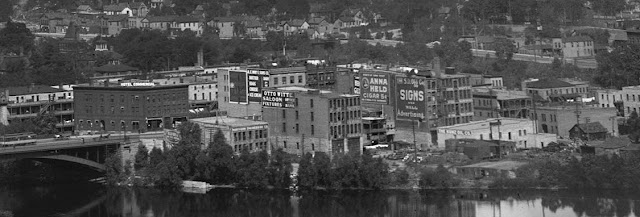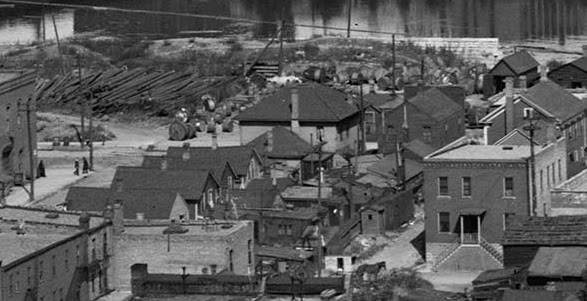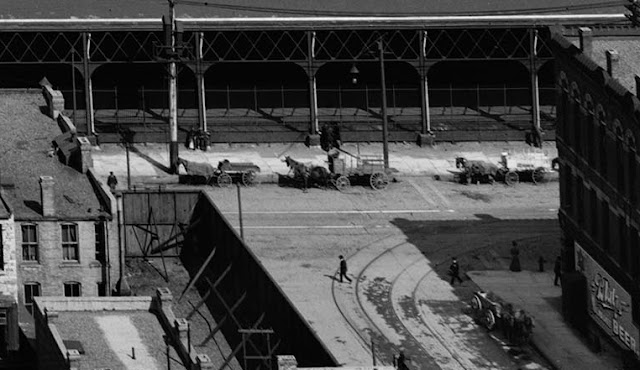 Some time ago, I fell into a photograph. It happened on Twitter. Someone tweeted a high-resolution image of Minneapolis in 1906, taken from the top of the brand new city hall. I clicked the link, and zoomed in, and a lost world opened up all around me. How different Minneapolis used to be! A city of smoke and dirt, chaos and men, industry and elegance. Drop someone from today's Minneapolis into this hundred year world, and they'd be lost.
Some time ago, I fell into a photograph. It happened on Twitter. Someone tweeted a high-resolution image of Minneapolis in 1906, taken from the top of the brand new city hall. I clicked the link, and zoomed in, and a lost world opened up all around me. How different Minneapolis used to be! A city of smoke and dirt, chaos and men, industry and elegance. Drop someone from today's Minneapolis into this hundred year world, and they'd be lost.A few details of this city long left behind...
The industrial riverfront:

I always knew that the riverfront was more industrial. It's part of the city narrative, the railyard along the river, the mill buildings lining both sides of the waterfall. But actually seeing the landscape is another thing altogether. Northeast Minneapolis looks like Mordor: treeless, black, piled with coal and train tracks and smokestacks and vast wide spaces on which you could safely land a zepplin. Today, that same space is covered with trees. It's "natural," green, parklike. But today's nature is a re-creation, a re-birth. There were no trees along the river. Everything was dirt or coal or congealed smoke. We imagine today's forest was always, that the trees tell tales of unborn factories. Here history and nature lie.
A bicycle:
There is a bicycle leaning on a stable. The transportation picture of 1906 includes riverboats, streetcars, horses and (for a brief time) bikes. The window for bicycles was maybe ten, maybe fifteen years, before they waned in popularity replaced by the motorcar and crowds. But I like to imagine walking out of the stable, smelling musty of manure and hay and the smoky city, and riding that bike along the rough streets down Washington Avenue to the North, weaving around the slowmoving horse-drawn wagons. What were the roads like? What were the tires like? What was the sunshine like? It must have been freedom felt to bike through the city, two or three miles to your small wooden house. Were there bike locks? Were the brakes effective? What did people shout at you as you went by? Did you tip your hat?
Stock Food:
On the Northeast riverbank sits the opulent “international stock food factory,” like something out of Willy Wonka. Nobody in their right mind would build such a factory these days. Today they're low concrete bunkers, spartan, functional, and grey. This one has an eight-story turret, Mansard roof, elaborate cornice, arched windows, columns in relief. Today on that same bit of earth, there is no trace of that grand structure. It is completely forgotten.
Depot top:

The old Milwaukee Road Depot. The Milwaukee Road has a fascinating history. Today, the depot is on ice. The clocktower is flat, its top was circumcised. Someone should try and put this back. Kickstarter turret top? Nearby, the top of the Northstar Blanket building advertises “slightly damaged” blankets for a one-third discount.
Nicollet Island:
Another of nature's falsities is this: Nicollet island is amazingly dense! Just a few of the things on the East end of the island: a coffin factory, something called “stock tonic”, a boiler works, “miracle pressure stove co.” The economic diversity is off any charts we might still have laying around. This was really the center of the center of the city, the center of the river. The river was the city. There were more people per square foot on this island than anywhere else in Minneapolis.

The rest of the island was the same way. We have such changing concepts of density. Anyone who says that Minneapolis is dense now hasn’t seen this history. Anyone who thinks Nicollet Island is a “city” today has a different definition of city than this. Every square inch of the place was covered in
bricks. Today it’s a park.
White men:

In the large railyard, men in white overalls sit half inside train cars. They seem to be hanging out, waiting for something to happen. My old uncle told me about a job he once had as a young man, working for a brewery in Saint Paul. Railcars would appear full of grain and a team of men with shovels would empty the car as fast as possible, working furiously to move the grain into the factory. When they were done, they'd get all the beer they could drink. Then they'd do it again. I imagine these men in white, sitting around talking about weather or houses or women in a language other than English, the huge railyard taking up the entire riverfront, filled with little clumps and pockets of these white men.
Shacks:
Amongst the large factories, the warehouses, and ornate civic buildings, slapdash shacks clutter themselves. These are obviously from an earlier era, about to be displaced by some brick mass. But there must have been many blocks like this, alleys and mud filled with small wooden structures connected to other wooden structures. It's amazing that even here, in the very heart of the city, you still get these small shacks. If there are so many here, imagine what Bohemian flats was like, or the North side. Imagine walking down this alley. Outhouses. Someone appearing out of a tiny hut, people lurking and living in cracks. In this alley, a lone horse hanging out.
Sidewalks:
A sidewalk covered in signs, wooden bits announcing grand things. The sidewalks are really wide. A lot must happen on them, people gathering, chatting, dealing, trading, strolling five wide. On this sidewalk, a guy selling something out of a donkey cart on the sidewalk. What is in there? Food or something else?
Imagination: See the horses and wagons hanging out by the train station. This was how you delivered anything, very slowly. Near to it, streetcar tracks curving along the roadways. I don't see any overhead electric wires... Who would I become if I lived here?






3 comments:
I've stared at this image for hours and hours, just love it so much. Need to figure out how to print a poster of it.
One of the first things I noticed was that Mill Place is easily spotted, right on 3rd behind the depot. Current view: http://goo.gl/maps/RmoKq
They didn't build factories like that in 1906 either. That stock food building was originally a convention center. It didn't last more than 20 years before going industrial, but it did host the 1892 republican national convention.
One more note - I beleive the boilerworks there is now the Nicollet Island Pavilion.
Thanks for sharing these photos. They are wonderful!
Post a Comment